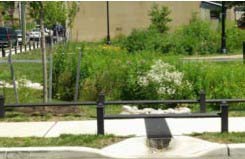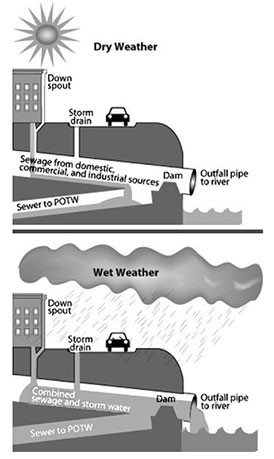December 9, 2020
DEP Milestone: It’s 2015, Stemming the Tide of Wastewater from Sewer Overflows

Goals as global as climate change initiatives and as local as sewer overflow issues all are part of the DEP’s work.
Nearly five years ago – on Dec. 12, 2015 – a global climate change pact was reached on reducing carbon emissions.
The accord, the first ever of its kind, was named the Paris Agreement. It was negotiated during the 21st session of the United Nations Climate Change Conference in Paris.
However, it would take almost another year before the pact would become effective, on Nov. 4, 2016, because the threshold for adoption would not be reached until October of that year. More than 55 countries, representing at least 55 percent of the world’s greenhouse gas emissions, ratified the agreement.
The aim of the agreement is to decrease global warming by:
- Holding the increase in the global average temperature to well below 2 degrees Celsius above pre-industrial levels and to pursue efforts to limit the temperature increase to 1.5 degrees Celsius above pre-industrial levels, recognizing that this would significantly reduce the risks and impacts of climate change;
- Increasing the ability to adapt to the adverse impacts of climate change and foster climate resilience and low greenhouse gas emissions development, in a manner that does not threaten food production;
- Making finance flows consistent with a pathway toward low greenhouse gas emissions and climate-resilient development.
Although the United States announced in 2017 that it would withdraw from the Paris Agreement and finalized that move on Nov. 4, 2020, President-elect Joe Biden has promised to rejoin the accord when he takes office in January.
In New Jersey, the Murphy administration has vowed to reach 100 percent clean energy by 2050, as well as fulfilling the Global Warming Response Act mandate of reducing state greenhouse gas emissions by 80 percent below 2006 levels.
As the DEP is working on efforts to achieve these goals, other areas that are part of our climate change strategy deal with water issues, including sewer systems. The department knows that storm sewers and sanitary sewers are two systems that work best when they work separately.
However, there are municipalities in New Jersey that have combined sewers systems and 2015 brought an effort to deal with overflow issues that can foul the state’s waterways.
And now, a look at 2015 …
The DEP took steps in 2015 to address the long-standing problem of combined sewer overflows by issuing 25 new permits that required operators to develop long-term control strategies and enhance public notification practices.

st modern sewer systems separate stormwater from sanitary wastewater. However, many older municipalities in New Jersey – mainly in the New York-New Jersey Harbor region of the urban Northeast – have combined systems in which stormwater is transported with household, commercial and industrial wastewater through the same pipe network.
Typically, combined wastewater is transported to a central treatment plant before being discharged into the environment. But during heavy rainfall or snowmelt events, older combined systems have a tendency to overflow, causing untreated sanitary sewage and stormwater to discharge directly into rivers and streams.
In 2015, there were 217 outfall pipes in 25 communities in the state, discharging billions of gallons of sewage a year into New Jersey rivers and bays.
The new state permits required towns to meet tougher standards and to develop plans to control discharges – by incorporating, for example, “green” infrastructure such as rain gardens or green roofs to capture stormwater.
“Combined sewer overflows are a very serious public health and environmental problem in a number of New Jersey’s communities,” said Joan Leary Matthews, then-Director of EPA Region 2’s Clean Water Division. “These new permits … help lead the way to improved water quality.”
on the taxpayer.”
###
 OFFICIAL SITE OF THE STATE OF NEW JERSEY
OFFICIAL SITE OF THE STATE OF NEW JERSEY